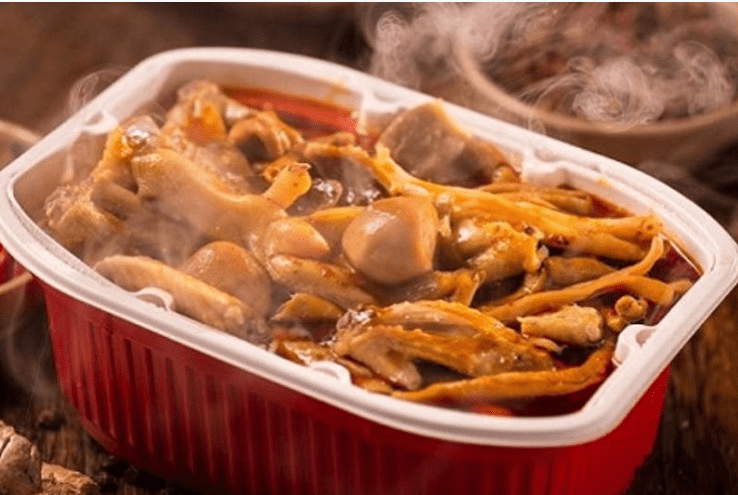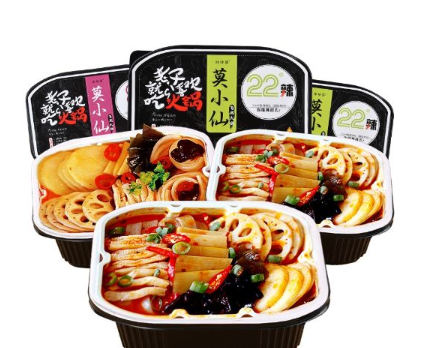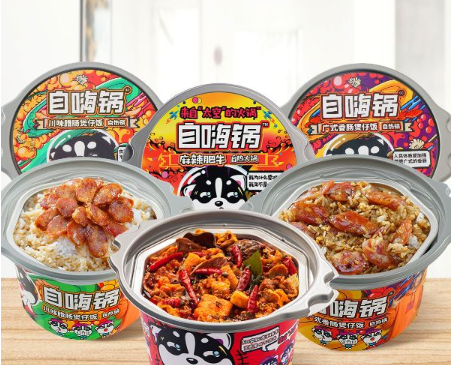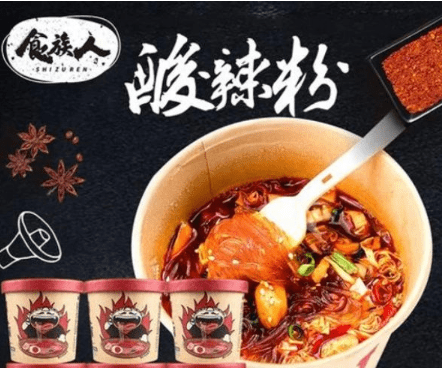As the name suggests, self-heating foods require no external heat source for preparation. Heat is generated by an exothermic reaction caused by adding room-temperature water to powdered minerals such as magnesium, iron and salt. The packaging is designed such that the hot water sits below the tray of food and steams it. As a result of the convenient packaging, the self-heating technique and products have upgraded and expanded the instant food category in China.
Self-heating instant foods achieved extraordinary sales during lockdown
The pandemic has seen sales of self-heating foods in China surge. Between late January and early February 2020, when the virus caused peak infections and China went into lockdown, sales of self-heating foods experienced the second-highest growth of all categories, year over year, according to Taobao, China’s largest online retailer. Sales of self-heating rice alone grew by 257%. They have enabled consumers to enjoy fuss-free dishes/hotpots/meals while restaurants were closed.

Self-heating start-up brands gain growth momentum after COVID-19 hit

Moxiaoxian (莫小仙)
Moxiaoxian has completed the series A funding with tens of million RMB in May, 2020.

Zihaiguo (自嗨锅)
Zihaiguo has received series B funding with hundreds of million RMB in May, 2020.

Shizuren (食族人)
Shizuren has completed the series A funding with tens of million RMB in May, 2020.
Self-heating instant food appeals to Chinese consumers as a premium, convenient offer
Inspired by military and emergency foods, self-heating foods were introduced to the Chinese market in 2016. Despite never really taking off in other markets previously, self-heating functionality gained traction when used to make instant hot-pot a possibility for fans of this dish. Self-heating hot-pot went viral through e-commerce platforms as it fits so perfectly into China’s ‘Lazy Economy.’ The popularity of self-heating foods was well-established and the category in strong growth prior to the COVID-19 pandemic. Despite its price point, at many multiples higher than other instant foods such as noodles, Chinese consumers have embraced the format. The market value of self-heating foods is estimated to double according to Mintel research on instant foods in China.
Hot-pot restaurants use self-heating products to extend to in-home consumption
A leading self-heating food brand is a famous hot-pot restaurant chain, HaiDiLao. It leverages the self-heating functionality to extend hotpot consumption, and it’s brand, to the in-home occasions. Despite its price point of around CNY40 per serve, it is an economical choice for those who cannot afford to dine in more frequently. Undoubtedly, the reputation of HaiDiLao has done much to enhance the image and attract consumers to the self-heating format. After the success of HaiDiLao, which launched in 2017, many hot-pot restaurant brands launched their own offers.
COVID-19 has made the self-heating format even more relevant. These products will remain attractive to foodservice operators as consumers can expect to remain cautious about eating out for some time.
Self-heating functionality makes convenient dishes more snackable
As a new type of instant foods, self-heating foods are mainly consumed for meal occasions, as is shown in the chart. However, besides functioning as a convenient meal, self-heating foods have the potential to enter snacking occasions. Empowered by the self-heating technique, instant food becomes more portable and convenient, which makes it a good choice as a savoury snack.
Target snacking occasions to drive more growth
The demand for consuming self-heating foods as snacks was already shown in consumers’ behaviour, while snacking brands have smelled this opportunity. Online snack giants such as Three Squirrels, Bestore and Be&Cherry have all entered this territory and launched their own self-heating products. Self-heating food brands can consider come up with products that are more suitable for snacking occasions, such as more flavour varieties, smaller portion, etc.
Self-heating technique could go into more categories and open up new consumption scenarios
With the power of the self-heating technique, more food and drink can offer portable warming options that fit more consumption occasions. Chinese consumers always prefer warm or room temperature food or drink, as it is perceived comforting to the digestive system and good for health. Snack or beverage products could offer warm products to appeal to Chinese consumers.
Self-heating technique is extending to more food and drink categories
Self-heating functionality can be used in more food and drink products and offer an enhanced consumer experience, which is comparable to what consumers can have in foodservice outlets. For instance, a self-heating pastry can be served at the optimal temperature to make it taste and smell as though it is fresh from the oven. The dessert can be consumed at the temperature it would be served in the restaurant.
What we think
Self-heating functionality has driven the significant, rapid growth of the instant food category in recent years, as it enables foodservice dishes, such as hot-pot, rice/noodles to be made available in a packaged, shelf-stable format via retailers. COVID-19 has caused sales to further escalate, as Chinese consumers seek elevated convenience and foodservice taste experience. The self-heating format has the potential to go into more categories such as snack, drink or even dairy, given the aversion many consumers have in China to chilled food and drink.









































